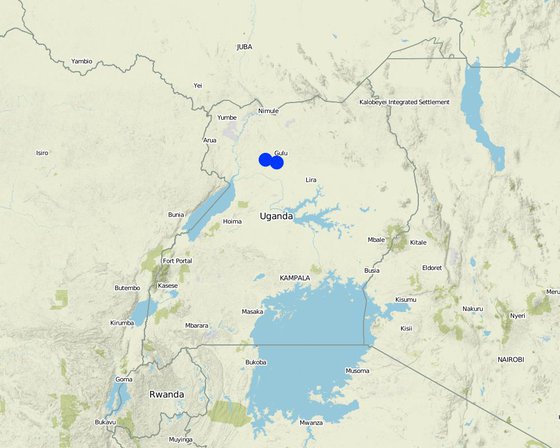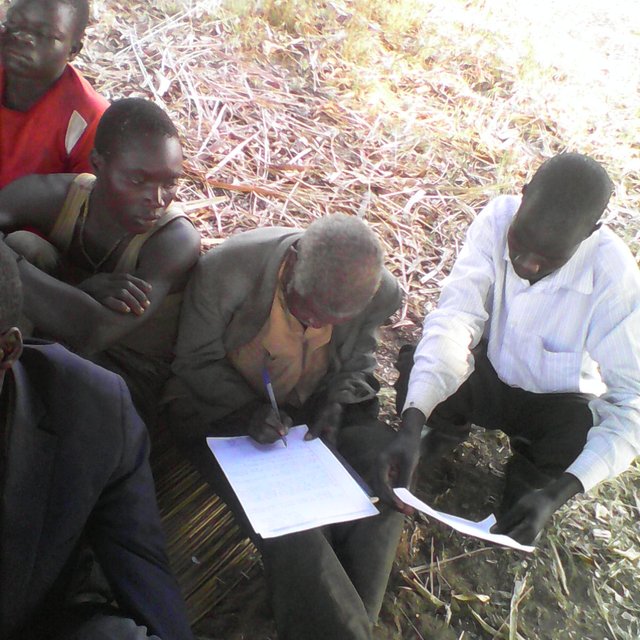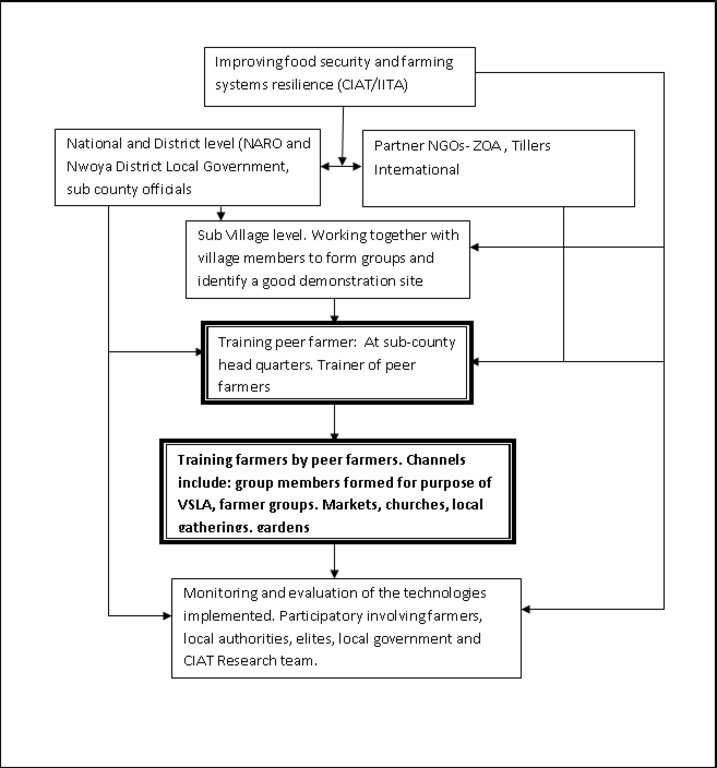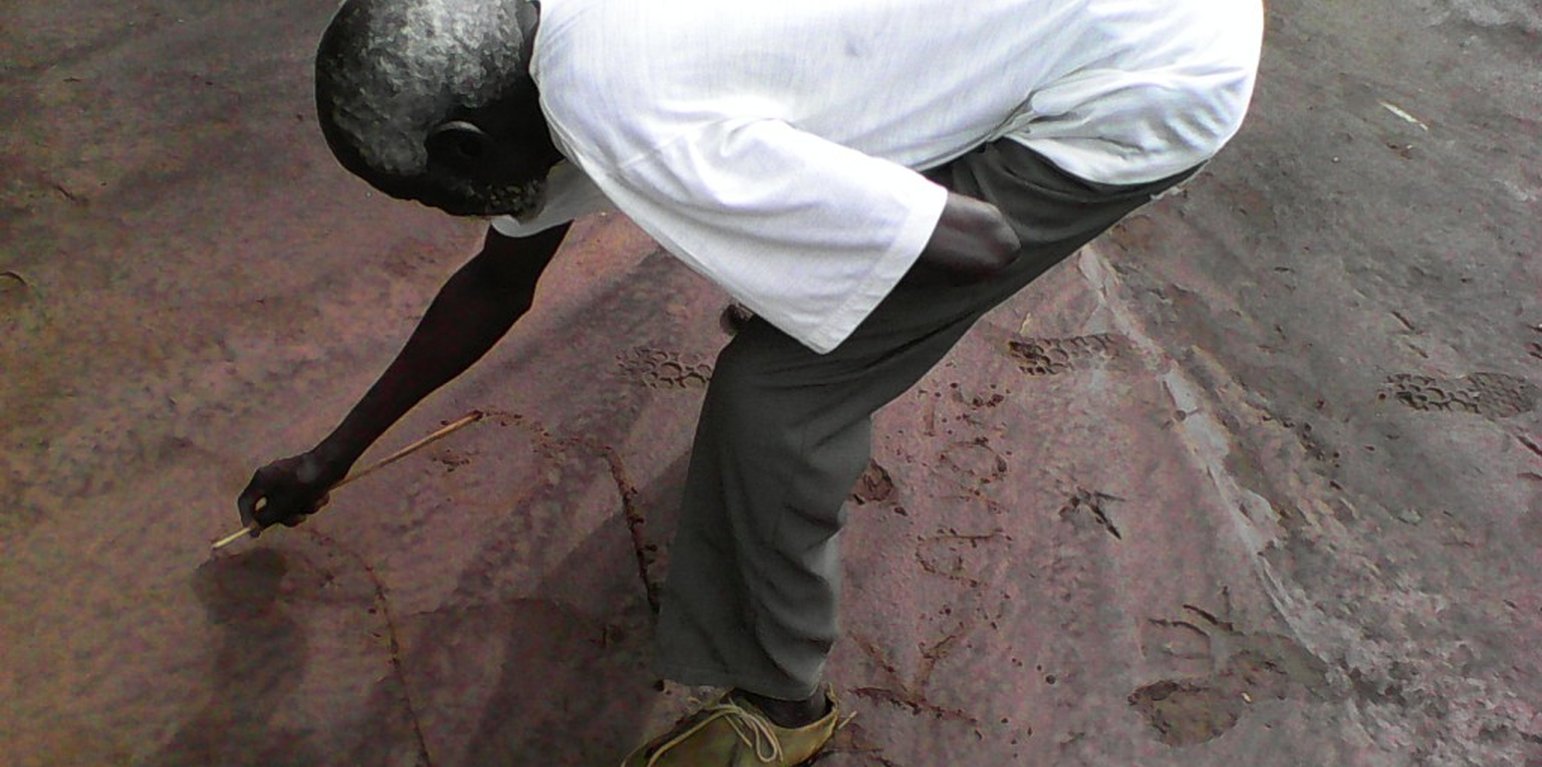Peer farmers as a village resource person for scaling Climate-Smart Agriculture (CSA) Practices
(Ouganda)
Lawang Lupur (Rwot Kweri)
Description
A prosocial behavior approach, where a peer farmer identified by other local farmers is trained on a technology and then used as a trainer for the fellow farmers (farmer group or neighbors).
Adoption of sustainable agricultural practices requires an in-depth understanding of the implementation, sustainability and the opportunity cost involved. Empowered local resource persons known as peer farmers are used by the International Center for Tropical Agriculture (CIAT) and International Institute of Tropical Agriculture (IITA) in Northern Uganda as channels to ensure that farmers understand the importance and implementation of Climate Smart Agricultural (CSA) Practices such as using conservation farming (CF) permanent basins.
A peer farmer in this case is a local community member whom the farmers identify as a potential trainer, very cooperative and, if trained would be willing to share the knowledge with other farmers in that community. After training the peer farmers, an incentive is promised to them based on their performance over time. This incentive is a commodity that is very cheap, but valuable, and not usually a farm input. In this case weighing scale was used as an incentive.
The peer farmer then uses all available methods and channels to pass on to the knowledge to other folks. The acquired knowledge and skills are usually shared through community meetings, religious gatherings, market places and so on.
The process of implementing this approach includes: Identifying the place of implementation, working with the farmers to identify a potential peer farmer, training the peer farmer, the peer farmer training other farmers over time and monitoring the progress of knowledge spill over. Stakeholders involved: Field staff - Work with farmers to identify and train peers, monitor activities; local leaders - organize community members; peer farmer - attend training, train other farmers.
This method is cheap, farmers identify someone with fairly good pro-social behavior, and farmers would be willing to learn from their own village member.
Lieu

Lieu: Alero Sub-county, Nwoya District, Ouganda
Géo-référence des sites sélectionnés
-
31.99964, 2.63475
-
32.00125, 2.63325
-
32.22205, 2.58247
-
32.22202, 2.58249
Date de démarrage: 2015
Année de fin de l'Approche: sans objet
Type d'Approche
-
traditionnel/ autochtone
-
initiative/ innovation récente locale
-
fondé sur un projet/ programme

a peer farmer showing practices (Amale Balla Sunday)
Objectifs de l'approche et environnement favorable
Principaux objectifs de l'Approche
Promoting adoption of Climate-Smart Agriculture through prosocial behaviour
Conditions favorisant la mise en oeuvre de la/(des) Technologie(s) appliquée(s) sous l'Approche
-
Normes et valeurs sociales/ culturelles/ religieuses : traditional relations among local communities
-
Cadre institutionnel: Agricultural Advisory services in the country, more NGOs operating in the agricultural sector
-
Collaboration/ coordination des acteurs: Participatory involvement of all the stakeholders in the agricultural sector
-
Cadre politique: PMA-Plan for Modernisation of Agriculture, a Government policy aimed at ensuring adoption of modern farming technologies.
Policy Action on climate change adaptation
Vision 2040 - A government policy aims at transforming Uganda's agriculture from subsistence to commercial farming.
-
Connaissances sur la GDT, accès aux supports techniques: Trainings from different agencies
-
Marchés (pour acheter les intrants, vendre les produits) et prix: high demands for food produce and favorable market prices with good roads
-
Charge de travail, disponibilité de la main-d'œuvre: use local people at their own times
Conditions entravant la mise en oeuvre de la/(des) Technologie(s) appliquée(s) sous l'Approche
-
Normes et valeurs sociales/ culturelles/ religieuses : limited cooperation among some communities
-
Connaissances sur la GDT, accès aux supports techniques: costs to fund the training of peer farmers
-
Marchés (pour acheter les intrants, vendre les produits) et prix: middle men cheat poor farmers
-
Charge de travail, disponibilité de la main-d'œuvre: illiteracy
Participation et rôles des parties prenantes impliquées dans l'Approche
Parties prenantes impliquées dans l'Approche et rôles
| Quels acteurs/ organismes d'exécution ont été impliqués dans l'Approche? |
Spécifiez les parties prenantes |
Décrivez le rôle des parties prenantes |
| exploitants locaux des terres / communautés locales |
farmers and local leaders |
implement the technology |
| organisations communautaires |
farmer groups |
used as a channel |
| Spécialistes de la GDT/ conseillers agricoles |
extension workers |
train on the SLM technologies |
| chercheurs |
CIAT/IITA |
Assess the degree of resilience |
| organisation internationale |
CIAT/IITA |
funding research activities |
Organisme chef de file
CIAT
Participation des exploitants locaux des terres/ communautés locales aux différentes phases de l'Approche
aucun
passive
soutien extérieur
interactive
auto-mobilisation
initiation/ motivation
CIAT project promoting food security and farming systems resilience in East Africa through wide-scale adoption of climate smart agriculture. The project is implemented in Nwoya district, designed by CIAT and funded by IFAD.
planification
CIAT/IITA: IITA became partner organisation for the project. Staffing was done through IITA, implemented in collaboration with IITA Uganda.
mise en œuvre
CIAT, IITA, Local government, National Agricultural Research Organisation, ZOA, Farmers, Extension agents
suivi/ évaluation
Participatory monitoring and evaluation involving all parties through farmers field days
Diagramme/ organigramme
detailed chart showing the different planyers in the approach

Auteur : Amale Balla Sunday
Prises de décision pour la sélection de la Technologie de GDT
Les décisions ont été prises par
-
les exploitants des terres seuls (auto-initiative)
-
principalement les exploitants des terres soutenus par des spécialistes de la GDT
-
tous les acteurs concernés dans le cadre d'une approche participative
-
principalement les spécialistes de la GDT, après consultation des exploitants des terres
-
les spécialistes de la GDT seuls
-
les responsables politiques/ dirigeants
Les décisions ont été prises sur la base de
-
l'évaluation de connaissances bien documentées en matière de GDT (prises de décision fondées sur des preuves tangibles)?
-
les résultats de recherches?
-
expériences et opinions personnelles (non documentées)
Soutien technique, renforcement des capacités et gestion des connaissances
Les activités ou services suivants ont fait partie de l'approche
-
Renforcement des capacités/ formation
-
Service de conseils
-
Renforcement des institutions (développement organisationnel)
-
Suivi et évaluation
-
Recherche
Renforcement des capacités/ formation
La formation a été dispensée aux parties prenantes suivantes
-
exploitants des terres
-
personnels/ conseillers de terrain
Formats de la formation
-
sur le tas
-
entre agriculteurs (d'exploitants à exploitants)
-
zones de démonstration
-
réunions publiques
-
cours
Service de conseils
Le service de conseils était fourni
-
dans les champs des exploitants?
-
dans des centres permanents
planned visits to peer farmers fields to observe what they are doing and advising them accordingly.
Renforcement des institutions
Institutions ont été renforcées ou mises en place
-
non
-
oui, un peu
-
oui, modérément
-
oui, beaucoup
Décrivez l'institution, ses rôles et responsabilités, ses membres, etc.
local farmer groups
Type de soutien
-
financier
-
renforcement des capacités/ formation
-
équipement
Plus de détails
Suivi et évaluation
Recherche
La recherche a traité les sujets suivants
-
sociologie
-
économie/ marketing
-
écologie
-
technologie
CIAT/IITA Research in Northern Uganda under the project; Promoting food security and farming systems resilience in East Africa through wide scale adoption of climate smart Agriculture (CSA)
Financement et soutien matériel externe
Budget annuel en dollars US de la composante GDT
-
< 2 000
-
2 000-10 000
-
10 000-100 000
-
100 000-1 000 000
-
> 1 000 000
Precise annual budget: sans objet
Les services ou mesures incitatives suivantes ont été fournis aux exploitants des terres
-
Soutiens financiers/ matériels fournis aux exploitants des terres
-
Subventions pour des intrants spécifiques
-
Crédits
-
Autres incitations ou instruments
Autres incitations ou instruments
weighing scale for best performers
Analyses d'impact et conclusions
Impacts de l'Approche
Non
Oui, un peu
Oui, modérément
Oui, beaucoup
Est-ce que l'Approche a autonomisé les exploitants locaux des terres, amélioré la participation des parties prenantes?
yes, improved group work
Est-ce que l'Approche a permis la prise de décisions fondées sur des données probantes?
decision made by community members
Est-ce que l'Approche a aidé les exploitants des terres à mettre en œuvre et entretenir les Technologies de GDT?
incentive driven
Est-ce que l'Approche a amélioré la coordination et la mise en œuvre de la GDT selon un bon rapport coût-efficacité?
farmers working with each other
Est-ce que l'Approche a mobilisé/ amélioré l'accès aux ressources financières pour la mise en œuvre de la GDT?
promoted group work but directed towards technology transfer
Est-ce que l'Approche a amélioré les connaissances et les capacités des exploitants des terres pour mettre en œuvre la GDT?
new technologies
Est-ce que l'Approche a amélioré les connaissances et les capacités des autres parties prenantes?
mostly farmers involved
Est-ce que l'Approche a construit/ renforcé les institutions, la collaboration entre parties prenantes?
different stakeholders participated
Est-ce que l'Approche a atténué les conflits?
improved social relations
Est-ce que l'Approche a autonomisé les groupes socialement et économiquement défavorisés?
did not focus on well off farmers, just anyone whom the community thinks has the potential to train local members
Est-ce que l'Approche a amélioré l'égalité entre hommes et femmes et autonomisé les femmes et les filles?
50% of trainers were women and at the end they performed better than the men trainers
Est-ce que l'Approche a encouragé les jeunes/ la prochaine génération d'exploitants des terres à s'engager dans la GDT?
ensure transfer to local people
Est-ce que l'Approche a amélioré les questions foncières et des droits d'utilisation qui entravent la mise en œuvre des Technologies?
Est-ce que l'Approche a conduit à améliorer la sécurité alimentaire et/ou la nutrition?
much higher increase in production
Est-ce que l'Approche a amélioré l'accès aux marchés?
good quality products
Est-ce que l'Approche a conduit à améliorer l'accès à l'eau et l'assainissement?
farm based
Est-ce que l'Approche a conduit à l'utilisation/ sources d'énergie plus durables?
farm based
Est-ce que l'Approche a amélioré la capacité des exploitants des terres à s'adapter aux changements/ extrêmes climatiques et a atténué les catastrophes liées au climat?
Est-ce que l'Approche a conduit à des emplois, des opportunités de revenus?
to trainers of peer farmers
Principale motivation des exploitants des terres pour mettre en oeuvre la GDT
-
augmenter la production
-
augmenter la rentabilité/ bénéfice, rapport coûts-bénéfices
-
réduire la dégradation des terres
-
réduire les risques de catastrophe
-
réduire la charge de travail
-
paiements/ subventions
-
règles et règlements (amendes)/ application
-
prestige, pression sociale/ cohésion sociale
-
affiliation à un mouvement/ projet/ groupe/ réseaux
-
conscience environnementale
-
coutumes et croyances, morale
-
améliorer les connaissances et compétences en GDT
-
améliorer l'esthétique
-
atténuer les conflits
Durabilité des activités de l'Approche
Les exploitants des terres peuvent-ils poursuivre ce qui a été mis en oeuvre par le biais de l'Approche (sans soutien extérieur) ?
The knowledge becomes local to the farmers; observes direct benefits whitin the shortest time of implementation, learn other things from neighbors without need for any motivation
Conclusions et enseignements tirés
Points forts: point de vue de l'exploitant des terres
-
farmers can easily learn from each other
-
peer trains farmers within their local environment
Points forts: point de vue du compilateur ou d'une autre personne-ressource clé
-
All available methods of passing information about the technologies are at the peer farmers disposal eg. market points, church, group meetings, tribal gatherings
-
farmers use their local language to teach/demonstrate to each other
Faiblesses/ inconvénients/ risques: point de vue de l'exploitant des terrescomment surmonter
-
difficult to train peer farmers
use practicals
-
peer farmers may not retain all the knowledge about the technology
use charts/pictures
Faiblesses/ inconvénients/ risques: point de vue du compilateur ou d'une autre personne-ressource clécomment surmonter
-
costly to organise trainings for peers
use local education facilities such as schools for training peer farmers
Références
Editors
-
JOY TUKAHIRWA
-
Kamugisha Rick Nelson
Examinateur
-
John Stephen Tenywa
-
Nicole Harari
Date de mise en oeuvre: 18 décembre 2017
Dernière mise à jour: 18 octobre 2018
Personnes-ressources
-
Kilama Odong - exploitant des terres
-
Micheal Sunday - None
Description complète dans la base de données WOCAT
Données de GDT correspondantes
La documentation a été facilitée par
Institution
- Uganda Landcare Network (ULN) - Ouganda
Projet
- Scaling-up SLM practices by smallholder farmers (IFAD)






